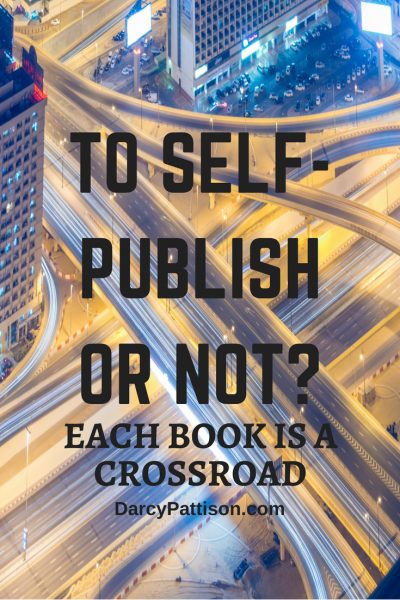Your first self-published book – the decision may take you by surprise. It did for me.
It was 2008. Since 1999, I’d traveled to teach my Novel Revision Retreat. The retreat’s workbook had grown from 30 pages to over 80 pages, which meant it was increasingly difficult for event coordinators to afford the printing. Then, I had a problem with one booking. We’d agreed on a price, but they came back and said they had to lower that price. It was still a decent fee, so I said, “OK. But participants will have to buy the workbook.”
[amazon_link asins=’0985213418′ template=’ProductAd’ store=’patty0d-20′ marketplace=’US’ link_id=’1d471dc7-8f6c-11e8-a797-136c192678b8′]Voila! I became a self-publisher. I published Novel Metamorphosis: Uncommon Ways to Revise, which is in its second edition. It happened because print-on-demand technology was so easy. You format the book (I used InDesign from the start), upload the files to the POD printer, and books are only printed when there’s an order. Slick. No boxes in my spare bedroom. And I got paid.
Your First Self-Published Book. Did you Plan it?”
It does happen that people decide to self-publish and then strategically plan the first book as the start of their list. But just as often, someone shrugs, and says to themselves, “Why not?”
The reality of self-publishing today is that it’s dead simple. So what if you publish a couple books and they do badly? You just want it “out there.”
One friend has started by publishing blank books as travel journals. The only difference from one journal to the next was the cover. Simple. What will she do next? There’s no plan for more, but after you break the ice, it’s likely that more will follow.
One friend is thinking about self-publishing a Bible study that she wrote.
Another published a story that she’d told to her grandchildren.
The step toward self-publishing is simple and risk-free. Buy a pre-made cover or hire a friend to do a quick Photoshop cover. Or, get a cheap Fiverr cover. Get the files uploaded.
It’s not great publishing by any means. I see these early efforts as something that allows you to try the process. Uploading blank book journals still means you walk through the entire process: creating files, dealing with ISBN (even if you use a free one from Createspace), creating accounts with the POD printers, checking sales, and getting paid. If you only make $5/month on those early books, it’s fine. They taught you what you needed to know.
Takeaway from Your First Self-Published Book
My takeaway on my first book was that I could actually do the whole process myself. I created about 30 covers before I decided I liked one. The interior formatting was harder because there was less help available. But I worked through it. Hey, I thought, I can DO this.
Some other lessons from the first book:
- Books don’t sell themselves. It’s a harsh reality that slapping a book up on Amazon doesn’t mean sales. Unless you market someway, it doesn’t happen. When I taught a Novel Revision Retreat, sales went up as participants told friends about the book. If there was a long time between retreats, sales slumped.
- People don’t care about HOW you published the book; they care about the CONTENT of the book. Participants in my retreats didn’t care that the book was published by my company. What they cared about was this: will it help me improve my novel? As long as everything looked professional, they didn’t care who published it. Of course, fiction is less forgiving than non-fiction, which is why non-ficiton is a good starting place.
- Quality is imperative. I knew right away that quality in layout, covers and copy editing was important. I was lazier about the copy editing part than I should’ve been. But no one is perfect in those early books. Because I’d been traditionally published (See my bibliography) before I turned indie, I knew the quality demanded by the marketplace. The first book taught me to respect that standard of quality.
- One thing leads to another. And after that first book, well, it just was easy to do the next and the next.
- And a thousand other small things that you’d do different the next time. . .
For most people I’ve watched, the decision to self-publish isn’t one decision: its an aggregation of many smaller decisions that lead you to this business plan for publishing. After the first book, it’s not a given that your next will be published the same way. The decision to really commit to self-publishing can be a long road with multiple cross roads.

Crossroads: Each Book is a New Decision
For example, your next manuscript. What will you do? It’s a crossroad for you. You can negotiate with yourself. Submit to XYZ editor at ABC company? Yes! But they can only look at it six months. I’m tired of slow rejections after twelve months, or three years. This time, they’ve got to decide and decide quick. Or I’m going to self-publish. You can change that decision at any time. Each book has its own decision process.
Those are the types of negotiations you do with yourself as you decide where your next book will land. And that’s OK. At each decision point, it’s OK to go the self-publishing route, and it’s OK to submit traditionally. It’s OK. The lines are blurred more than ever, and each book represents a choice. How and when will your first self-published book happen? Look out. Accidents happen!
Isn’t it great?

